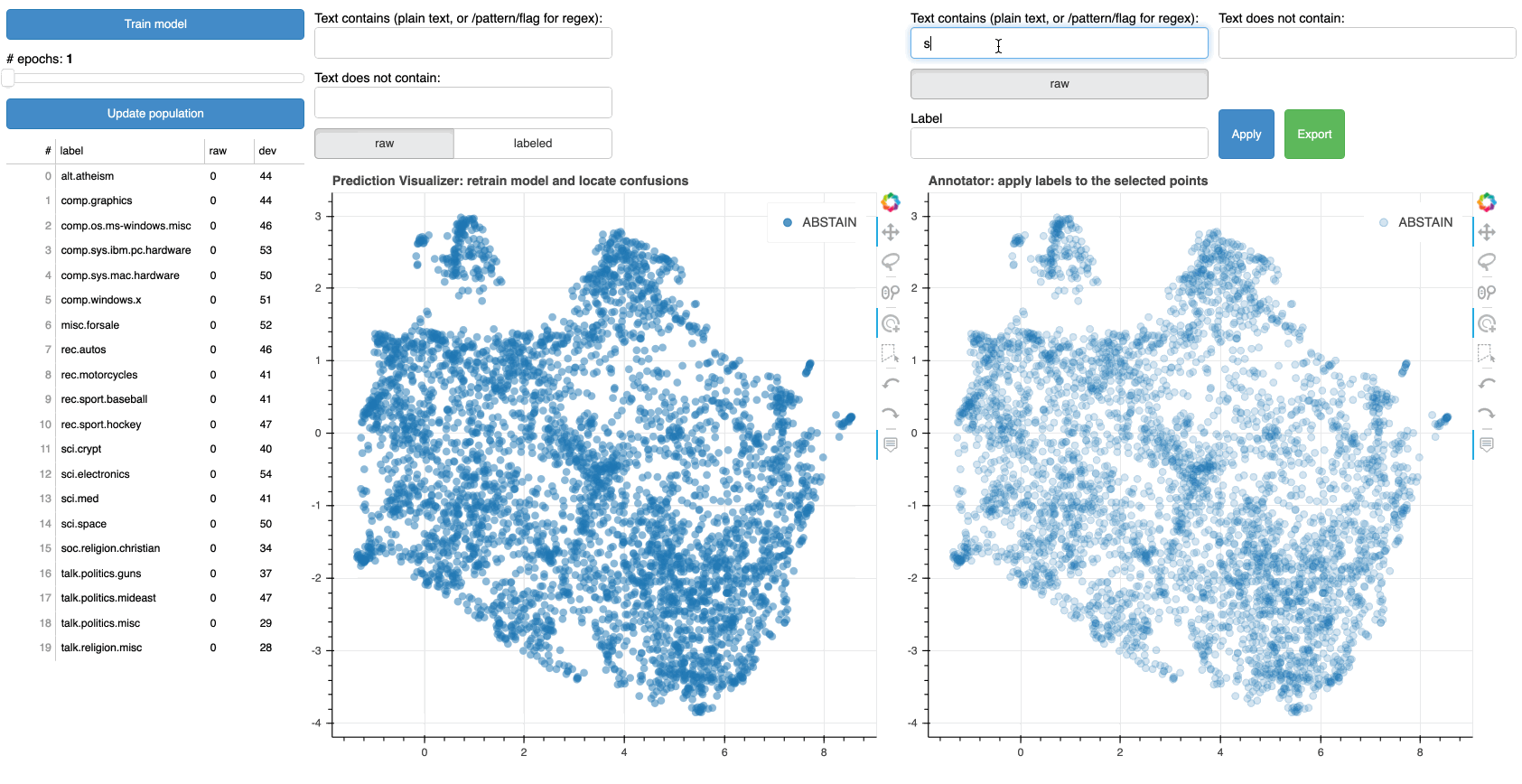hover
Imagine editing a picture layer by layer, not pixel by pixel, nor by splashing paint.

We can apply this idea to datasets.
Hover is a machine teaching library that enables intuitive and effecient supervision. In other words, it provides a map where you hover over and label your data... differently. For instance, you can:
:seedling: annotate an intuitively selected group of data points at a time
:ferris_wheel: throw a model in the loop and exploit active learning
:whale: cross-check with Snorkel-based distant supervision
Check out @phurwicz/hover-binder for a complete list of demo apps.
:flags: Latest Announcements
-
Dec 16 We decided to make notebook tutorials instead of videos, because
hoveris now embeddable in Jupyter notebooks, and- active development tends to outdate video tutorials rather quickly.
-
Dec 12 Common usage workflows are now available in
hover.recipes. Much cleaner code!
:flight_departure: Quick Start
Step 0: load your dataset
from hover.core.dataset import SupervisableTextDataset
dataset = SupervisableTextDataset(
raw_dictl=[{"content": "this is great"}], # the raw data to be supervised
# train_dictl=[], # train/dev/test sets can be empty
dev_dictl=[{"content": "this is awesome", "mark": "A"}],
test_dictl=[{"content": "this is meh", "mark": "B"}],
feature_key="content", # specify feature/label keys
label_key="mark",
)
# define a vectorizer for your feature, then call dimensionality reduction
import spacy
nlp = spacy.load('en')
vectorizer = lambda text: nlp(text).vector # we recommend wrapping a @lru_cache around this
dataset.compute_2d_embedding(vectorizer, "umap")
Step 1: choose a recipe
(or create your own with
examples)
from hover.recipes import simple_annotator
handle = simple_annotator(dataset)
Step 2: fire it up
Hover uses bokeh to deliver its annotation interface:
option 1: in Jupyter
from bokeh.io import show, output_notebook
output_notebook()
show(handle)
option 2: with
bokeh serve
from bokeh.io import curdoc
doc = curdoc()
handle(doc)
option 3: elsewhere as an embedded app
from bokeh.server.server import Server
server = Server({'my-app': handle})
server.start()
:package: Installation
Python: 3.6+
OS: tested on Mac & Linux
To get the latest release version, you can use pip:
pip install hover
Installation through conda is not yet available. Please open an issue if you would like conda or conda-forge support.
:flamingo: Features
Here we attempt a quick comparison with a few other packages that do machine teaching:
| Package | Hover |
Prodigy |
Snorkel |
|---|---|---|---|
| Core idea | supervise like editing a picture | scriptable active learning | programmatic distant supervision |
| Annotates per | batch of just the size you find right | piece predicted to be the most valuable | the whole dataset as long as it fits in |
| Supports | all classification (text only atm) | text & images, audio, vidio, & more | text classification (for the most part) |
| Status | open-source | proprietary | open-source |
| Devs | indie | Explosion AI | Stanford / Snorkel AI |
| Related | many imports of the awesome Bokeh |
builds on the Thinc/SpaCy stack |
Variants: Snorkel Drybell, MeTaL, DeepDive |
| Vanilla usage | define a vectorizer and annotate away | choose a base model and annotate away | define labeling functions and apply away |
| Advanced usage | combine w/ active learning & snorkel | patterns / transformers / custom models | transforming / slicing functions |
| Hardcore usage | exploit hover.core templates |
custom @prodigy.recipe | the upcoming Snorkel Flow |
Hover claims the best deal of scale vs. precision thanks to
- the flexibility to use, or not use, any technique beyond annotating on a "map";
- the speed, or coarseness, of annotation being literally at your fingertips;
- the interaction between multiple "maps" that each serves a different but connected purpose.



